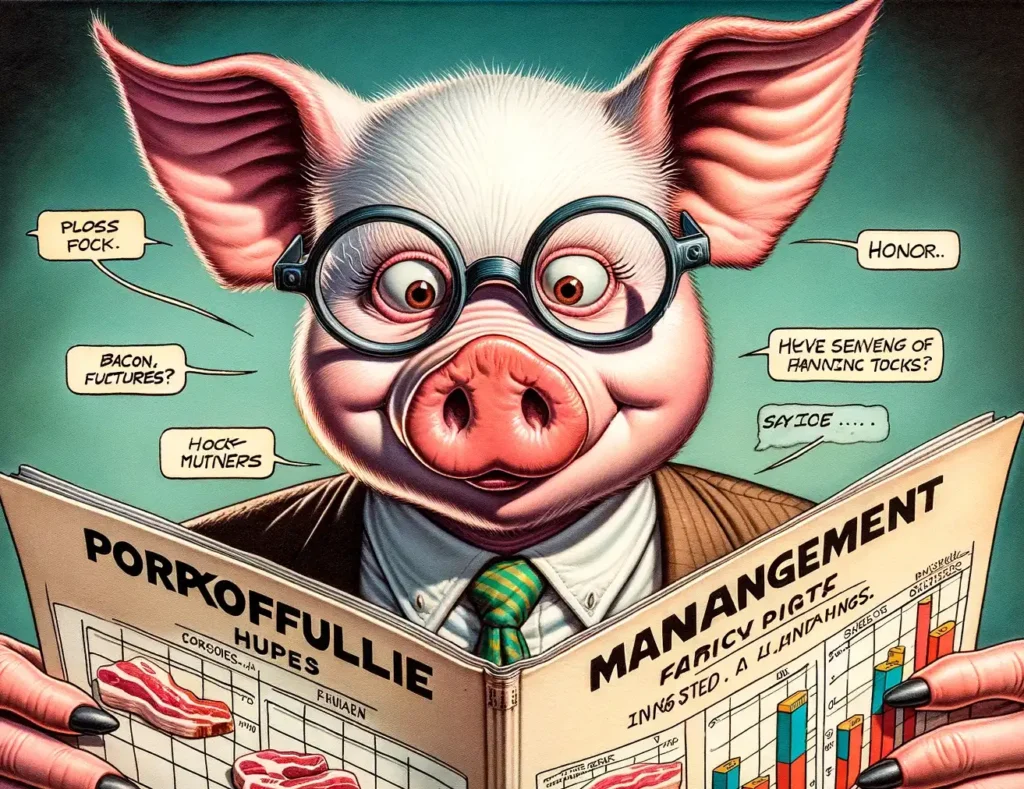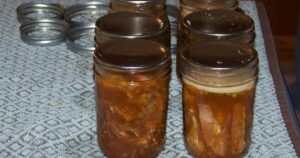
Piggy Banks A humorous and detailed close up illustration in the style of Mad Magazine depicting Porkfolio Management. The scene shows a pig managing its portfo2.webp.webp
Piggy Banks: Saving Money with Real Pigs
The world of finance is no stranger to innovation. From the advent of paper currency to the creation of complex financial instruments like derivatives and credit default swaps, the goal has always been to make managing money more effective and, let’s be honest, more confusing. But just when you thought you’d seen it all, along comes a trend that’s poised to turn the financial world on its head: saving money with real pigs. That’s right, folks—introducing the literal piggy bank.
Imagine a world where your savings grunt and squeal with excitement whenever you make a deposit. Welcome to the new age of “oinkonomics,” where barnyard banking is the latest craze. Instead of handing your hard-earned money over to a bank with interest rates that barely beat inflation, you can now invest in something more tangible, more personable, and definitely more porcine: real, living pigs.
It starts with a simple idea. Buy a pig, feed it, and watch it grow. Every time you throw some corn into its pen, you’re effectively making a deposit. The pig gets fatter, symbolizing your growing wealth. But be warned—this isn’t just any savings account. These pigs require maintenance, care, and a lot of mud. In return, they provide a unique, tangible experience of saving money.
Truffle Treasury and Porkfolio Management
In the old days, pigs were used to find truffles in the forest. Now, they’re sniffing out financial opportunities. Truffle hunting has evolved into the ultimate in porkfolio management. It’s like having a snout that can sense hidden wealth. You thought you were clever investing in tech stocks? Try investing in a pig that can find $1,000 truffles in the woods. Now that’s a return on investment!
Porkfolio management isn’t just about truffles, though. It’s about diversifying your assets in ways you never thought possible. Investing in pigs means you have a stake in bacon futures, ham stocks, and the ever-lucrative sausage securities. Plus, there’s the added bonus of enjoying the fruits (or meats) of your investment.
Hogging Savings and Barnyard Banking
No more arguments about who gets to control the household savings. In the world of barnyard banking, the pig decides. It’s a democracy of the porcine kind. You simply can’t argue with a pig when it comes to saving strategies. They’re natural savers, after all, hoarding everything from food scraps to shiny objects.
Interest rates? Forget about them. The only rates that matter in this economy are how much feed you can buy and how quickly your pig can turn it into delicious bacon. It’s a system that runs on simplicity and the joy of watching your pig get bigger and happier.
Snout to Savings and Penny in a Blanket
Depositing money has never been easier. Just feed the pig. Want to withdraw? That might involve a bit more squealing and perhaps a wrestling match, but hey, that’s the price you pay for this kind of personalized banking experience. Plus, there’s nothing quite like the feeling of rolling your savings in a literal pig—penny in a blanket, if you will.
The Hog Heaven Savings Plan is perfect for those looking to diversify their retirement portfolios. Forget about stocks, bonds, and mutual funds. Your future is secure in the form of a happy, healthy herd of pigs. And when it’s time to retire, you can rest easy knowing that your assets are safely rolling in the mud.
Piggy Plunder and Swine Investment Strategy
Of course, there are risks. Pigs can be greedy. If you notice your pig gaining weight faster than usual, it might be eating up more than just corn. But fear not! Every good investment comes with risks. And besides, the joy of seeing your pig flourish outweighs any potential downside. Just keep an eye on your piggy’s diet.
As for swine investment strategy, it’s simple: keep your pig happy, healthy, and well-fed. A content pig is a productive pig, and that means more bacon for you. Cryptocurrency might be the future, but for now, the real trend is in pork-based investments. Move over, Bitcoin. Here comes bacon.
Greedy Pig and Oinker ROI
The only thing better than saving money is saving money that you can eventually eat. Return on Investment (ROI) has never been so delicious, especially when it’s bacon. Your pig grows, your savings grow, and when the time is right, you have a feast to celebrate your financial acumen.
Hamlet’s Hedge Fund and Pigs in the Market
Even William Shakespeare would be impressed by this inventive approach to financial planning. Hamlet’s Hedge Fund has nothing on the simplicity and effectiveness of saving money with pigs. It’s a strategy that’s as old as time but reinvented for the modern world.
In conclusion, the piggy bank has come full circle. From clay figurines to digital apps, and now, back to the barnyard. It’s time to embrace the future of savings. Pigs in the market might sound absurd, but in a world where financial stability is as uncertain as the weather, sometimes the best investment is the one that oinks.
The Financial Benefits of Piggy Banks
The financial world is often intimidating and inaccessible to the average person. Stocks, bonds, ETFs, and other complex instruments require a level of expertise and often a broker to manage them. But what if the secret to financial success lay not in Wall Street but in the humble barnyard? By investing in pigs, you tap into a simpler, more intuitive form of savings. Pigs, after all, have been a part of human agriculture for thousands of years, and their ability to convert feed into weight (and thus value) is unmatched.
Practical Aspects of Pig Savings
The practicality of this system cannot be overstated. For starters, pigs are relatively low-maintenance compared to other livestock. They don’t require the vast grazing lands that cows do, nor do they need the constant attention that chickens might. With a modest investment in a sturdy pen, some quality feed, and basic veterinary care, your piggy bank will thrive. And unlike traditional banks that charge fees for maintaining your account, your only ongoing costs are food and care, both of which contribute directly to the growth of your savings.
Community and Cultural Impact
This approach to savings also fosters a stronger connection to your community and environment. By participating in local agriculture, you’re supporting sustainable practices and contributing to the local economy. Imagine the pride in explaining to your neighbors that your financial future is secure thanks to your diligent care of your prized pigs. It’s a conversation starter at any gathering and a testament to innovative thinking.
Piggy Banks: A Symbol of Financial Rebellion
In a world dominated by digital transactions and intangible assets, the real piggy bank stands as a symbol of financial rebellion. It’s a return to the basics, a rejection of the overly complicated systems that often leave ordinary people confused and disenfranchised. By investing in pigs, you’re not just saving money; you’re taking a stand against the impersonal nature of modern finance. Your pig represents a tangible, living testament to your financial acumen and resourcefulness.
The Future of Piggy Banks
As we look to the future, it’s clear that the concept of piggy banks—real, oinking, mud-rolling piggy banks—has the potential to revolutionize the way we think about saving money. It’s practical, sustainable, and undeniably charming. So next time you’re considering how best to save your hard-earned cash, perhaps it’s time to head to the nearest farm supply store rather than the nearest bank. Invest in a pig, and watch your savings grow—quite literally.

Disclaimer
This story is entirely a human collaboration between a cowboy and a farmer. No pigs were harmed in the making of this satire, though several might have enjoyed a bit too much corn. Always consult a financial advisor before investing in livestock. Remember, this advice is as serious as a pig in a tutu.
15 Humorous Observations
- Literal Piggy Bank: Who knew that piggy banks could actually be pigs? Talk about taking things literally!
- Oinkonomics: The best kind of savings account oinks when you feed it. Move over, Wall Street!
- Truffle Treasury: Pigs finding truffles in the forest is like them sniffing out hidden wealth. Truffle hunting is the new stock trading.
- Porkfolio Management: Diversifying your assets now includes investing in bacon futures and ham stocks.
- Hogging Savings: No more fights over whose money goes where. The pig decides, and you don’t argue with a pig.
- Barnyard Banking: Forget about interest rates. The only rates that matter are the ones involving how much corn you have.
- Snout to Savings: Deposits are as simple as feeding the pig. Withdrawals might involve a bit more squealing.
- Penny in a Blanket: Rolling up your savings in literal pigs might smell funny, but it’s a guaranteed way to protect your assets.
- Hog Heaven Savings Plan: Your retirement plan now includes a farm, a herd of pigs, and a lot of patience.
- Piggy Plunder: When you realize your savings are being enjoyed in the form of mud baths and belly rubs.
- Swine Investment Strategy: Move over, cryptocurrency. The new trend is in pork-based investments.
- Greedy Pig: Beware of the pig that starts gaining weight faster than usual. He might be eating up your savings!
- Oinker ROI: Return on Investment has never been so delicious—especially when it’s bacon.
- Hamlet’s Hedge Fund: William Shakespeare would be proud of this inventive approach to financial planning.
- Pigs in the Market: Watch out, Wall Street! Here comes the livestock revolution, with pigs as the new brokers.
Types of Pig and Farmer Interactions
Piggy Banks, Pigs, Hogs, Swine, Truffle hunting, Oinkonomics, Porkfolio management, Truffle pigs, Pig breeds, Berkshire, Duroc, Hampshire, Yorkshire, Hog farming, Pig husbandry, Mud-rolling pigs, Feed-to-weight conversion, Pig care, Pig pen setup.

Originally posted 2010-08-03 11:03:59.
Originally Published at FarmerCowboy.com
2024-09-01 21:08:47
Karl Hoffman is a distinguished agriculturalist with over four decades of experience in sustainable farming practices. He holds a Ph.D. in Agronomy from Cornell University and has made significant contributions as a professor at Iowa State University. Hoffman’s groundbreaking research on integrated pest management and soil health has revolutionized modern agriculture. As a respected farm journalist, his column “Field Notes with Karl Hoffman” and his blog “The Modern Farmer” provide insightful, practical advice to a global audience. Hoffman’s work with the USDA and the United Nations FAO has enhanced food security worldwide. His awards include the USDA’s Distinguished Service Award and the World Food Prize, reflecting his profound impact on agriculture and sustainability.







Hilarious! Had to send this to my friends! ??